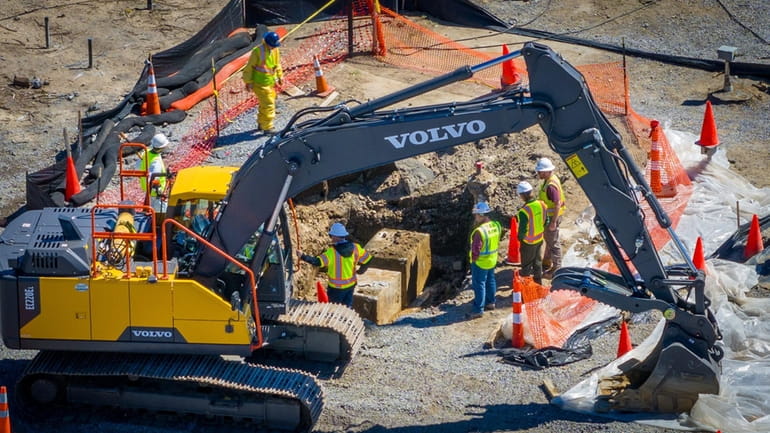4 more chemical drums removed from Bethpage park pit, with new layer found that could have more

Work was underway at a dig site at Bethpage Community Park on Tuesday, when contractors removed four chemical drums following the removal of six such drums on Monday. The operation at the former Grumman Aerospace dumping ground also revealed a layer of concrete under the four drums that could contain more drums, according to state officials. Credit: Newsday/J. Conrad Williams Jr.
Contractors removed four more chemical drums from a Bethpage Community Park pit Tuesday, according to a top state official, who said their extraction at the site where Grumman Aerospace dumped toxins decades ago revealed a third layer of concrete that could contain more drums.
“We need to let our technical experts do their job and tell us what's in there,” Sean Mahar, interim commissioner of the New York State Department of Environmental Conservation, said of the third layer in an interview. “It could have been something that was just formerly on the site that they buried over with these drums or it could be another concrete vault containing drums. But until we get in there and have more information, I don't want to speculate.”
Testing was underway Tuesday on the contents of the four drums that were found within a second layer of concrete, according to the DEC.
On Monday, contractors removed six 55-gallon drums containing waste petroleum and chlorinated solvents that three weeks ago were discovered about four feet from the surface and encased in a primary layer of concrete.
WHAT TO KNOW
- Six 55-gallon, concrete-encased chemical drums were unearthed Monday from a former Grumman Aerospace dumping site in Bethpage Community Park after their March 28 discovery.
- Four more drums were removed Tuesday from a second underground layer of concrete at the site.
- A third layer of concrete was discovered and could contain more drums, state officials said.
A total of 10 drums have been unearthed since the discovery of the first set last month.
Northrop Grumman, the corporate successor of Grumman Aerospace, confirmed Tuesday the company was conducting an excavation to determine if there were additional drums encased in the third layer of concrete at the underground site.
“We remain committed to protecting the health and well-being of the community as we address environmental conditions in Bethpage,” Grumman spokesman Vic Beck said.
The third layer of concrete was located 10 to 12 feet from the surface, according to the DEC.
Mahar said Tuesday that one of the four newly found drums may have disintegrated within the second layer of concrete. But he said nothing was leaking into the surrounding environment.
On March 28, Grumman contractors found the first six drums while drilling a well on the former ballfields to check an existing soil treatment system at the park.
The DEC previously described the substances found in the first drums as “consistent with known historic operations” of Grumman and the U.S. Navy that are the focus of the ongoing cleanup effort on the property.
The agency also said earlier this month that the first set of drums posed “no immediate threat to public health and safety at the site.”
The dig site is on a 3½-acre closed section of the 18-acre town park. Ballfields and a skatepark are shut down at the facility, but much of the park remains open.
Grumman donated land for the park to the town in 1962, before contamination was found in 2002 in ballfield soil. The dumping on the park site was found to be a major contributor to an underground plume of carcinogenic chemicals that is more than four miles long, two miles wide and 900 feet deep.
Nearly 26 years after the first cleanup efforts began, the plume of contamination continues to move south at the rate of about a foot a day, Newsday has reported.
Northrop Grumman will continue to use ground-penetrating radar to scan throughout the park to see if other materials are hidden underground, according to Mahar.
The original six drums were put in special bins for testing after their removal Monday and will end up at an out-of-state site that handles hazardous waste, according to state officials.
An excavator is being used to dig the hole at the park, which now has expanded to a size of 25 by 40 feet, according to Oyster Bay spokesman Brian Nevin. He said Tuesday the layer of concrete in which the second set of drums was encased measured 3 by 20 feet.
Oyster Bay Supervisor Joseph Saladino said Tuesday that Northrop Grumman's contractors removed the drums in the second layer of concrete, which was reinforced with rebar, by using a machine that acts like a large jackhammer to carefully break the concrete containing the drums into smaller sections before lifting them out.
Saladino added that the latest discovery proves the situation “is far worse” than Grumman, which the town sued last year over a ballfield soil cleanup agreement from 2013, let on.
“It proves that we need a full remediation and a full evaluation of drums anywhere and everywhere, and it proves that we have to go much further to force Grumman to excavate all contaminated soil and ship it off Long Island,” he said.
With Tracy Tullis
Two body parts suspects in court ... Teen chicken keeper ... Rangers advance ... Penn upgrades
Two body parts suspects in court ... Teen chicken keeper ... Rangers advance ... Penn upgrades

